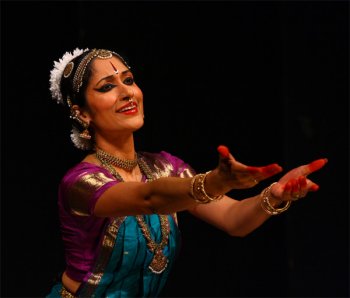
|   |

|   |
In search of glory - Padma Jayaraj e-mail: padmajayaraj@gmail.com Photo: Praful Parameswar November 21, 2012 Rasavikalpam, music - dance festival, organized by the Kerala Sangeetha Nataka Akademi in Thrissur has become an annual feature. Among the many recitals, the dance lovers of Thrissur saw a Bharatanatyam presentation by Janaki Rangarajan.  Refreshingly different, the solo performance was a dazzling presentation in technical brilliance and outstanding abhinaya. A disciple of Padma Subrahmanyam, the artist moves forward in changing times and perceptions. The innovative choreography within the bounds of tradition, brilliant nritta, and striking poses, are the hallmarks of her performance. The recital as a single whole had many levels. In music it was a journey from Kanakangi to Purni lead by the orchestra: the vocalist A.S. Murali, nattuvangam – Sreekant, violin - Kandadevi S Vijayaraghavan, mridangam - Haribabu. Thematically, it was an odyssey from waiting to union in tune with the Hindu philosophy. The recital began with the traditional invocation: Siva in the form of Gajasamhara, the presiding deity of Vazhuvoor in Tamilnadu, the village deity of her guru. In another sense it was an offering to her guru as well. Kavithwam, in praise of the dancing Ganapathy, composed by Madhurai Muralidharan in raag Kanakangi, adi thalam, followed. We got a sample of her choreography, original to the core. The elephantine stances were sculptures coming alive. The dancing Ganesa poised with his trunk in blessing remained etched like a tableau. For a moment I felt droplets of blessings showered all over. The positive energy sent from the dancer enveloped the entire auditorium. The varnam was a composition of Swathi Thirunal in raag Karnataka Kapi, roopaka thalam. It was a long piece dedicated to waiting, the pangs of torment, endless waiting. The nayika, a sakhi, goes to Lord Padmanabha. She prays to protect her friend from the agonized love that is smothering her. The pain of falling in love, how crazy one goes because of the anguish of unspoken love is narrated in a heart-wrenching manner. The lover’s plight in her world of fantasy is a concoction of bitter sweet pain. Once upon a time, it was the ethos both in life and aesthetics in India. The anguish of waiting as seasons fade through crushed hopes is a poignant painting. The pose of eternal waiting remains like a monument, by just prolonging the moment, a longer, slower movement as in Odissi, something unusual in Bharatanatyam, made the presentation memorable. At the mystical level, it evoked the great poignancies of the soul sojourning through human incarnations waiting, waiting in silence… while the Lord Padmanabha remains like a still, cast in ananthasayana. Ashtapadi Yahi Madhava yahi Keshava followed in raag Sindhubharavi, adi thalam, almost as a relief from the intensity of grief. A sensuous beginning - Radha as she weaves a floral strand to deck her hair enjoys the scent of a flower; she hears the flute. And Krishna staggers in with the telltale marks of an amorous battle. From elation she moves on to disgust. Here, the woman could at least speak, express her revulsion although she has to endure the pain of deceit that lovers have suffered all through human history. Thaye Yasoda, an abhinaya piece composed by Oodhukadu Venkata Subbaiyyer in ragam Thodi, adi thalam showcased the shock of surprise, in a superb manner. The Gopi comes complaining to Yasoda. Krishna, the naughty child idolized in Indian hearts is painted in added colors. The naughty boy Krishna, a darling child when embraced with the warmth of maternal love, kissed her on her lips like a lover… the shock at his mischief that smacks of Krishna the lover of later times, is the highlight of the piece. Again, pulling at her sari, the impish Krishna demanded butter. Placing the child on her lap, she feeds him. But his open mouth with the cosmos whirling within, terrified her! Transferring the original story to a different context to suggest a different shade of meaning was a remarkable twist. The Thillana, the crowning piece was a composition by T. Vaidyanatha Bhagavatar in raag Poorvi, roopaka thalam. A mystical piece: AUM, the pranava manthra was cast in pure, abstract dance. A prismatic display of aum in saptaswara! The rare chemistry between the orchestra and the dancer climbed greater heights. Whether music inspired dance or dance inspired music was difficult to tell. Aum… rising through the chakras opens up the path for kundalini, for the soul through the crown to get united…the jeevatma merges with the paramatma…the union is complete. In celestial bliss, the chant of Santhi manthra reverberated, as Aarsha Bharata has chanted it down the ages. Based in the US, Dr. Janaki Rangarajan is a success as a touring performer. As a dancer she does not belong to a particular school. Her style, in the process of evolution is a mix at present. Innovation is the strong point. As she moves from the portal of the temple of dance to its sacred interiors, there as she prostrates in all humility, grace will flow from the deity. And Janaki is bound to compose soul-stirring pieces in divine inspiration, for glory has a divine dimension that need not be associated with success. Padma Jayaraj is a freelance writer and a regular contributor to narthaki.com |